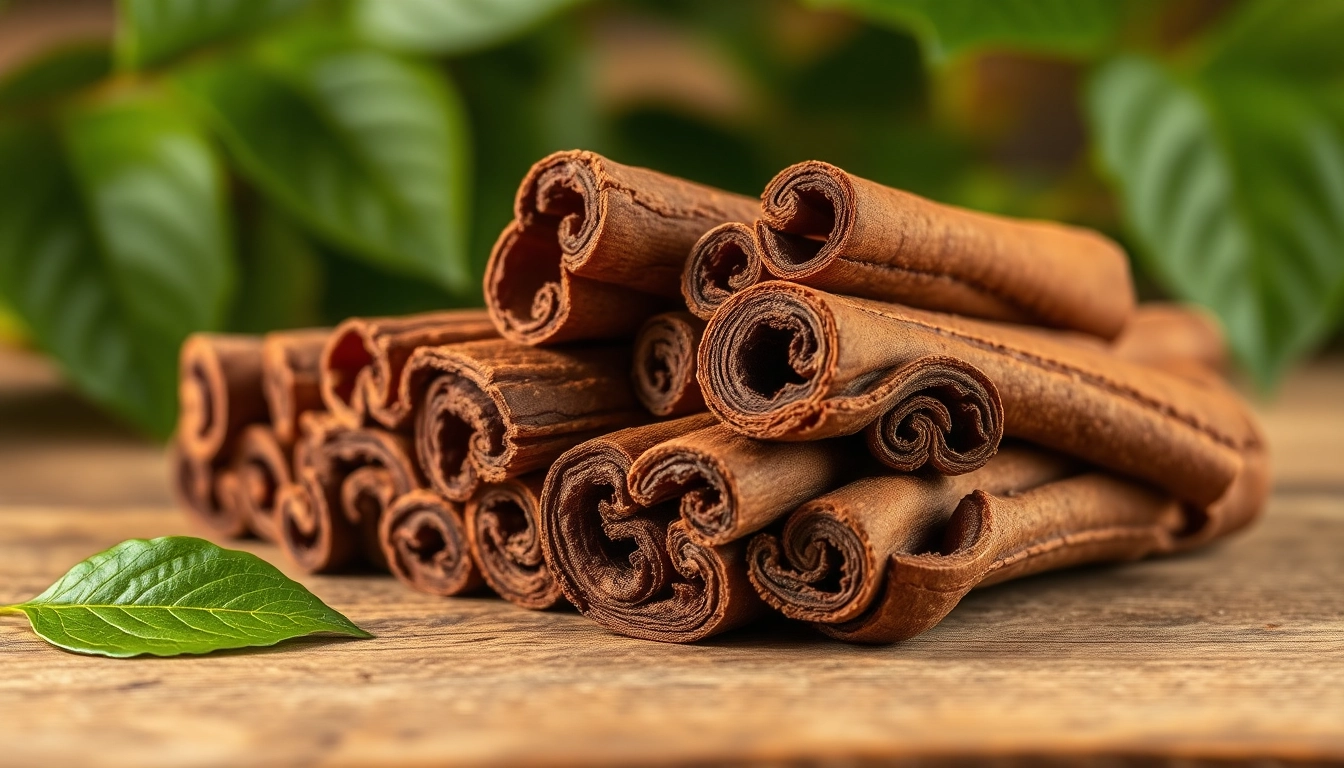
Unveiling the Wonders of Cinnamon Bark: Health Benefits, Uses, and Culinary Delights
Introduction to Cinnamon Bark
Cinnamon bark has held a prestigious place in the culinary and medicinal worlds for thousands of years. Its captivating aroma and unique flavor make it a cherished spice in kitchens around the globe. Beyond its use as a cooking ingredient, cinnamon bark is celebrated for various health benefits and traditional medicinal uses. In this comprehensive guide, we will explore the rich history, health benefits, culinary applications, potential risks, and tips for selecting the highest quality cinnamon bark.
What is Cinnamon Bark?
Cinnamon bark is derived from the inner bark of trees belonging to the genus Cinnamomum. As a spice, it comes primarily from two popular species: Ceylon cinnamon (or “true” cinnamon) and Cassia cinnamon, also known as Chinese cinnamon. These varieties differ in flavor, aroma, and chemical composition. Ceylon cinnamon is prized for its milder, sweeter taste and lower coumarin content, while Cassia has a more pungent flavor and a coarser texture. The bark is harvested by cutting the stems of the trees, allowing the inner bark to be removed and dried into the familiar quills or ground into powder.
Different Types of Cinnamon Bark
Understanding the distinctions between the types of cinnamon bark is crucial for consumers looking to maximize their culinary and health benefits. The two primary varieties are:
- Ceylon Cinnamon (Cinnamomum verum): Also known as “true cinnamon,” this variety is primarily grown in Sri Lanka and has a delicate flavor profile. It is often preferred for its health-promoting properties and lower levels of coumarin, a substance that can be harmful in excessive amounts.
- Cassia Cinnamon (Cinnamomum cassia): native to Southeast Asia and widely available in supermarkets, Cassia cinnamon is more affordable and abundant. However, it contains higher coumarin levels, which may pose health risks if consumed in large quantities.
Historical Significance of Cinnamon Bark
The use of cinnamon bark dates back over 4,000 years, with ancient Egyptians utilizing it for embalming and as a valuable trade good. It was revered in ancient texts, including the Bible, where it was mentioned as an essential ingredient in holy anointing oil. Throughout history, this aromatic spice has inspired exploration and trade routes, leading to its prominence in European cuisine during the Middle Ages. Today, cinnamon bark remains a staple in culinary practices worldwide, cherished for both its flavor and health benefits.
Cinnamon Bark: Health Benefits
Cinnamon bark is not just a flavor enhancer; it also boasts an array of health benefits that have been substantiated through research and traditional practices. Here we delve into some of the most significant health advantages associated with its consumption.
Antioxidant Properties of Cinnamon Bark
Rich in polyphenols, cinnamaldehyde, and other antioxidants, cinnamon bark is a potent defender against oxidative stress in the body. Antioxidants play a vital role in neutralizing free radicals—unstable molecules that contribute to chronic diseases and aging. Studies have shown that cinnamon can reduce markers of oxidative stress, potentially lowering the risk of conditions such as heart disease and diabetes.
Digestive Benefits and Uses
Cinnamon bark has long been used in traditional medicine for its digestive benefits. It can improve gastrointestinal health by alleviating symptoms such as bloating, gas, and indigestion. The spice aids in stimulating digestion by increasing insulin sensitivity and slowing the breakdown of carbohydrates in the digestive tract. Its antimicrobial properties also promote gut health by inhibiting the growth of harmful bacteria.
Cinnamon Bark in Traditional Medicine
In many cultures, particularly within Ayurveda and Traditional Chinese Medicine (TCM), cinnamon bark is classified as a warming spice, making it popular for treating colds, flu symptoms, and menstrual cramps. Its natural anti-inflammatory properties make it effective at reducing pain and inflammation. Furthermore, it may contribute to managing blood sugar levels, thereby benefiting those with diabetes or insulin resistance.
Culinary Uses of Cinnamon Bark
Both Ceylon and Cassia varieties of cinnamon bark lend unique flavors that enhance an array of dishes. Understanding its culinary applications can elevate the dining experience.
Cooking with Cinnamon Bark
Cinnamon bark can be used in various savory dishes, particularly in Middle Eastern and Indian cuisine. It is commonly added to stews, curries, and marinades, where its warm, woody flavor can infuse the dish. Experts recommend using whole bark sticks to flavor broths, allowing it to simmer gently to release its aroma and depth.
Cinnamon Bark in Baking and Desserts
Bakers have long understood the magic of cinnamon in desserts. From classic cinnamon rolls to spiced cakes and apple pies, the bark adds warmth and a comforting essence to sweet dishes. Ground cinnamon is often preferred for baking, but whole pieces can be incorporated to infuse flavor in syrups or custards.
Infusing Flavors: Beverages and Spice Blends
Cinnamon bark is also prominent in beverages. Cinnamon-infused teas can be brewed by steeping whole sticks in hot water, while it is a key ingredient in spiced wines and holiday favorites like mulled cider. Furthermore, it can be blended with other spices to create warmth in chai mixes or seasoned cocktails. For those looking to enhance savory drinks, a cinnamon stick can be used as a stirring stick, imparting its flavor gradually.
Potential Side Effects of Cinnamon Bark
While cinnamon bark is generally safe for most individuals, it’s essential to understand potential side effects and precautions before regular consumption.
Understanding Safety and Risks
Excessive consumption of cinnamon bark, particularly Cassia, may lead to adverse effects due to its high coumarin content. High coumarin intake can cause liver damage in sensitive individuals and lead to respiratory problems if inhaled. It’s crucial to moderate intake and consider the source of the cinnamon to ensure safety.
Interactions with Medications
Cinnamon might interact with certain medications, including anticoagulants and blood sugar-lowering drugs. This interaction could enhance their effects, leading to excessive insulin sensitivity or bleeding risks. Individuals on these medications should consult with healthcare professionals before including significant amounts of cinnamon in their diets.
Dosage Recommendations
The safe daily intake of cinnamon bark varies, but a common recommendation is about half to one teaspoon of ground cinnamon or one to two sticks of whole cinnamon bark. Pregnant women and individuals with liver conditions should exercise particular caution and seek advice from their healthcare provider before consumption.
Choosing Quality Cinnamon Bark
To reap the maximum benefits of cinnamon bark, it’s essential to choose high-quality products. Here are some guidelines to follow.
How to Identify Quality Cinnamon Bark
When selecting cinnamon bark, look for quality indicators. Ceylon cinnamon has a softer, more brittle texture, while Cassia is hard and woody. The bark should have a rich, sweet aroma, and any variations in color should be consistent with the specific type of cinnamon. Ground cinnamon should appear fine and not clump together—signs of moisture or poor quality.
Where to Buy Cinnamon Bark
High-quality cinnamon bark can be found at health food stores, specialty spice shops, and online retailers. Look for certified organic options when possible, as these are often free from additives or contaminants. Additionally, consider buying in bulk to ensure freshness, particularly if you use cinnamon frequently in your cooking.
Storing Cinnamon Bark for Freshness
Proper storage of cinnamon bark is vital for preserving its flavor and potency. Store whole sticks in an airtight container in a cool, dark place. Ground cinnamon should be kept in a similar manner, preferably in a sealed container to prevent moisture exposure. With adequate storage, whole cinnamon bark can last for several years, while ground cinnamon retains optimal flavor for about six months to a year.
Conclusion
As we have explored, cinnamon bark is far more than just a flavorful addition to your recipes; it is a versatile ingredient with a rich history and numerous health benefits. By understanding its types, health properties, culinary uses, potential side effects, and how to choose quality products, you can best utilize this remarkable spice. Incorporating cinnamon bark into your diet may lead to delightful culinary experiences while also contributing to your overall health and well-being.


